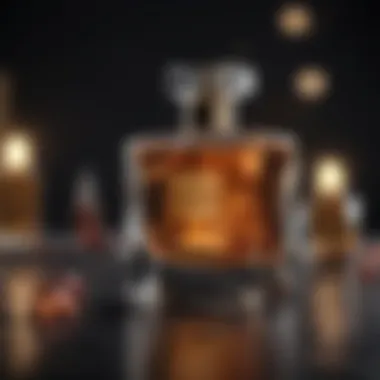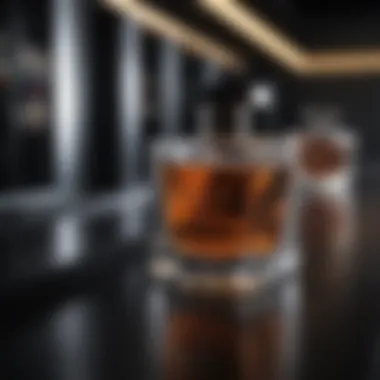Strategies to Ensure Long-lasting Fragrance


Intro
In a world where scents play a critical role in personal expression, understanding how to make them last longer is essential. With the right strategies, one can maximize the potency of fragrances, providing a lasting impression. This guide aims to break down the core elements that influence fragrance longevity, which include the composition of perfumes, the science behind scent notes, and the individual characteristics of skin types.
Moreover, environmental aspects and application methods significantly affect how long a scent stays. This knowledge is crucial for anyone wishing to optimize their fragrance experience, from casual users to enthusiasts who cherish every nuance of their favorite scents. By addressing every relevant factor, this guide will empower readers to make informed choices, turning a daily routine into an enriched sensory experience.
Understanding Fragrance Composition
Fragrance composition is a critical aspect in maximizing the longevity of scent on the skin. Understanding how various elements interact allows users to make informed choices, ultimately enhancing the wear time of their favorite perfumes. Each fragrance is carefully crafted using a combination of notes that together create the overall scent profile. Being knowledgeable about these components can lead to better selection and application strategies.
Top, Middle, and Base Notes
Fragrance notes are divided into three categories: top, middle, and base notes. The top notes are the scents perceived immediately upon application. These notes are often fresh and light, such as citrus or herbal elements. They create the initial impression but evaporate quickly, typically lasting from 15 minutes up to an hour.
Next, we have the middle notes, which are also known as heart notes. They emerge after the top notes fade and form the core of the fragrance. Middle notes generally include floral or fruity scents, lasting longer than top notes, about two to six hours. Importantly, these notes help to smooth the transition to the base notes.
Finally, the base notes are the foundation of the fragrance and determine its lasting power. These notes are deep and rich, often derived from resins, woods, or vanilla. Base notes can linger on the skin for many hours, sometimes even days, contributing significantly to a fragrance's overall longevity.
How Note Structure Affects Longevity
The structure of fragrance notes plays a vital role in determining how long a scent lasts on the skin. A well-balanced perfume incorporates a harmonious combination of top, middle, and base notes. When the balance is executed correctly, the scent will evolve beautifully over time, with each note complementing the others.
Fragrances with a higher concentration of base notes often have better longevity. This is because base notes evaporate slowly, allowing them to linger longer. Conversely, fragrances dominated by top notes may offer a fresh burst initially but can fade rapidly.
To select a perfume that lasts, consider the balance of notes within the composition. Knowing how different notes behave helps in both choosing the right fragrance and applying it effectively for maximum duration.
"Understanding the layers of fragrance is key to making informed choices on what will last throughout the day and into the evening."
In summary, a strong grasp of fragrance composition, particularly the role of top, middle, and base notes, enhances the user experience. Carefully considering the note structure can lead to intelligent choices in perfumes that align with user preferences and desire for longevity.
Factors Influencing Perfume Longevity
In the realm of fragrances, understanding the elements that affect longevity is paramount for any perfume enthusiast. These factors collectively determine how long a scent lasts after application. Each individual's skin chemistry, the moisture level of their skin, and the surrounding environmental conditions contribute significantly to the longevity of perfume. By grasping these elements, one can make informed decisions to enhance the lasting power of their favorite fragrances.
Skin Chemistry and pH Levels
The nature of one’s skin plays a critical role in how long a fragrance persists. Every person has a unique skin chemistry, influenced by various factors such as diet, hormonal balance, and genetics. This chemistry interacts with the perfume, altering its composition and scent profile. Additionally, the pH level of the skin can change the fragrance’s behavior. A more acidic skin surface can cause fragrances to evaporate more quickly, while neutral or slightly alkaline skin may enhance the fragrance’s longevity.
It is useful to remember that perfumes may react differently on different individuals, so testing them on your skin is essential.
Moisture Levels of the Skin
Hydrated skin tends to hold fragrance better than dry skin. When skin is moisturized, it creates a better surface for the perfume, slowing down the rate of evaporation. Applying a fragrance on well-hydrated skin helps in amplifying its presence and duration. For best results, consider using an unscented moisturizer before applying your fragrance. This not only enhances the scent but also keeps the skin soft and supple, promoting longer-lasting fragrance retention.
Therefore, keeping your skin moisturized is a simple yet effective strategy for improving fragrance longevity.
Environmental Conditions
The environment in which one resides or spends time can greatly affect how a fragrance behaves on the skin. Factors such as humidity and temperature play a crucial role. For example, in hot weather, fragrances may evaporate quickly due to increased temperatures, causing them to last shorter. On the other hand, humidity can enhance diffusion, allowing the scent to project further.
Indoor environments can also have an impact. Air conditioning can dry out the air and affect the skin's moisture levels. In colder conditions, perfumes tend to last longer, as lower temperatures slow down evaporation rates.
Being aware of these environmental factors enables one to strategically choose fragrances and adjust application techniques based on the conditions, optimizing their fragrance experience.
Application Techniques for Enhanced Duration
Application techniques are crucial in ensuring that your chosen fragrance lasts throughout the day. Many factors come into play, from choosing the right areas of application to the methods through which the fragrance is applied. Each aspect contributes significantly to how well a scent will hold onto the skin, offering both convenience and longevity.


Common Application Areas
Knowing where to apply perfume can dramatically enhance its longevity. The most effective spots are pulse points, which include:
- Wrists: This area provides warmth and helps release fragrance.
- Behind the Ears: Heat tends to emanate here, allowing the scent to diffuse throughout the day.
- Neck and Décolletage: These regions also engage warmth and area for aroma diffusion.
- Inner Elbows: Applying fragrance here makes for a lasting effect as it stays hidden yet perceptible.
Tip: Some individuals find the back of the knees effective as well. This is especially true for warmer days when movements release captivating scents.
Layering Fragrances
Layering involves using multiple fragrances or complementary products like body lotion to create a unique scent profile while enhancing longevity. Here are a few strategies for effective layering:
- Use unscented or lightly scented lotions to moisturize your skin before application. This creates a base for the perfume.
- Consider mixing different scents that share similar notes or contrasts satisfyingly. For example, a floral scent can become intriguing with a woody undertone.
- Fragrance oils can also be layered with a perfume. Apply the oil to the skin and then spray the perfume on top.
Layering can be a personalized experience, allowing your fragrance to work uniquely for your skin chemistry while increasing the overall longevity.
Spraying vs. Dabbing
Both spraying and dabbing perfume have their benefits, and the choice between them can impact fragrance durability. The following points shed light on each method:
- Spraying: This method is often preferred for its efficiency. By creating a fine mist, it can cover a larger area and encourage even distribution. It enables air interaction, which allows the top notes to present themselves beautifully in the initial phases. However, be mindful for over-spraying, which can lead to intensity rather than lasting power.
- Dabbing: Dabbing offers controlled application. It is particularly effective for concentrated perfumes, allowing for precise placement on pulse points. The downside is that it may not diffuse scent as well as spraying. Yet, it can lead the fragrance to last longer and develops fuller on the skin.
Choosing the Right Perfume Type
Selecting the appropriate perfume type is crucial for enhancing the longevity of your chosen scent. Various perfume types possess different concentrations that significantly impact their duration on the skin. Understanding these distinctions is vital, as it allows individuals to make informed decisions when purchasing fragrances. Selecting a perfume that adheres to personal preferences while also aligning with intended usage can lead to a more satisfying olfactory experience.
Eau de Parfum vs. Eau de Toilette
Eau de Parfum (EdP) and Eau de Toilette (EdT) differ notably in terms of scent concentration, leading to varying longevity and character. Eau de Parfum typically contains a higher concentration of fragrance oils, generally ranging from 15% to 20%. This increased potency allows for a more intense fragrance experience, ensuring that the scent can last longer throughout the day. In contrast, Eau de Toilette tends to have a lighter concentration, around 5% to 15%. It offers a fresher scent experience but often fades more quickly.
Choosing between EdP and EdT ultimately depends on personal taste, occasion, and desired longevity. For a long-lasting fragrance, Eau de Parfum is often the preferable choice. However, purchasing Eau de Toilette can be beneficial for casual or daytime wear, where a subtler scent is desired.
Concentrations and Their Effect on Longevity
The concentration of fragrance oils in a perfume is a significant determinant of its longevity. Higher concentrations generally mean that the scent will last longer after application. Here are the primary categories of fragrance concentrations:
- Parfum: The most concentrated, ranging from 20% to 30% of fragrance oils. It lasts the longest, often exceeding eight hours or more.
- Eau de Parfum: Contains 15% to 20% fragrance oils. Usually lasts between four to eight hours depending on skin chemistry.
- Eau de Toilette: Has about 5% to 15% fragrance oils. Typically lasts around three to five hours, making it suitable for lighter applications.
- Eau de Cologne: Contains around 2% to 5% fragrance oils. This option is very light and may last under three hours.
Each type serves distinct purposes, from daily wear to special occasions. For those aiming for a lasting scent, focusing on higher concentrations, such as Eau de Parfum or Parfum, is advantageous.
Choosing the right perfume type ensures not only satisfaction but also the engagement of your senses throughout the day.
Understanding these elements equips you with the knowledge to select fragrances that resonate with your personal style and meet the demands of your lifestyle.
Storage Recommendations for Fragrance Products
When it comes to preserving the quality and longevity of fragrances, proper storage is critical. Fragrance products are sensitive to various external factors, and without adequate care, they can lose potency or change their scent profile. In this section, we will explore the ideal storage conditions, along with the effects of light and temperature on fragrance integrity. Understanding these elements is essential for anyone looking to extend the life of their favorite perfumes.
Ideal Storage Conditions
Storing fragrance correctly is an often overlooked yet vital aspect of maintaining its quality. Here are some key recommendations for ideal storage conditions:


- Cool, Dry Places: Maintain a stable temperature. Ideally, the storage area should be cool, between 15-20 degrees Celsius (59-68 degrees Fahrenheit). Avoid placing fragrances neat radiators or in direct sunlight.
- Closed Containers: Always keep the cap tightly sealed. Air exposure can lead to oxidation, which diminishes the scent.
- Avoid Humidity: High humidity can also compromise the fragrance's structure. Storing in bathrooms, where moisture levels fluctuate, is not advised.
- Upright Position: Store bottles upright rather than on their side to prevent leakage and maintain seal integrity.
By taking these steps, you can significantly enhance the lifespan of your fragrance products, ensuring that they remain as potent as possible.
Effects of Light and Temperature
Light and temperature are two of the most important external factors affecting the longevity of fragrances. Both can trigger chemical reactions that alter a perfume’s composition. Here’s how:
- Impact of Light: Ultraviolet (UV) rays can break down the molecules in a fragrance, leading to changes in color and scent. It is essential to store fragrances in dark-colored bottles or amber glass. Additionally, placing them in opaque boxes or out of direct sunlight minimizes exposure to harmful light.
- Fluctuating Temperatures: Sudden changes in temperature can disrupt the stability of fragrance. Heat can make the notes in a perfume evaporate, while extreme cold may alter the consistency. It is crucial to avoid storing fragrances in places where temperatures rise and fall frequently.
Proper storage ensures that the fragrance retains its original scent and potency over time, enhancing the overall experience and ensuring long-lasting enjoyment.
Taking the time to implement these storage recommendations will not only protect your investment but will also guarantee that you enjoy your beloved scents at their best for longer.
Testing Perfume for Longevity
Testing perfume for longevity is a pivotal aspect that many consumers overlook. Understanding how a fragrance lasts on different skin types and in various circumstances can save time and resources. It allows individuals to choose perfumes that will remain fragrant through daily activities and environmental changes.
By considering longevity, you’re not only making informed purchasing decisions but also enhancing the value of your fragrance collection. The two main methods of testing involve skin patch testing and evaluating how fragrances perform in various settings. This process ensures you are aware of a fragrance's behavior, enabling you to enjoy it over extended periods without the need for constant re-application.
Skin Patch Testing
Skin patch testing is an effective method to evaluate how long a fragrance will last on your skin. It involves applying a small dose of the perfume directly to a clean area of skin, typically on the wrist or inner elbow. This area is sensitive, which allows for more accurate results in terms of scent perception and longevity.
Benefits of Skin Patch Testing:
- Personalized Results: Each person’s skin chemistry is unique. Patch testing helps you see how the perfume interacts with your skin.
- True Longevity Assessment: This method provides a realistic sense of how the fragrance will hold up throughout the day.
- Minimizes Waste: Testing on your skin helps avoid purchasing fragrances that may not perform as expected, leading to money saved in the long run.
When conducting skin patch tests, consider the following:
- Timing: Test in the morning to evaluate how the scent develops throughout the day.
- Environment: Keep the testing period consistent, ideally in indoor conditions, to eliminate variables like humidity and temperature which could skew results.
Testing in Different Environments
Perfume longevity can vary greatly based on the environment. Testing fragrances in different settings offers insights into how they last under specific conditions. This is particularly useful for someone who spends time in various climates or environments.
Key Aspects to Consider:
- Humidity Levels: High humidity can enhance the perception of fragrance, while low humidity may cause it to dissipate faster.
- Temperature: Heat generally amplifies scents, which might lead to a stronger olfactory experience but may also compromise longevity.
- Activity Levels: Testing a fragrance while engaged in physical activity can help assess how it holds up during sweat and movement.
Here are some steps for effective environmental testing:
- Select Different Locations: Try the perfume outdoors, in air-conditioned spaces, and in heated environments.
- Record Results: Keep track of your observations. Note how long the scent remains noticeable and any changes in its profile.
- Evaluate Variability: Be mindful of how each setting alters the overall experience of the perfume.
"By combining both skin patch testing and environmental testing, individuals can make informed decisions for selecting fragrances that ensure lasting impressions."
Through these two methods, testing perfume for longevity becomes a thorough process. The right approach not only allows lotion lovers to discover their ideal scents but also ensures those scents remain delightful throughout the day.
Fragrance Recommendations Based on Longevity
In the quest for a long-lasting fragrance, the selection of the right scent plays a crucial role. Each fragrance has its own unique profile, affecting how long it will linger on the skin. This section explores various categories of fragrances that are recognized for their enduring properties, helping readers make informed choices.


Understanding the right type of fragrance can enhance one's experience, providing richness in aroma while ensuring longevity. Choosing scents that resonate not only with personal style but also with lasting power is imperative. This can translate into a more effective fragrance strategy, contributing to overall satisfaction with the chosen product.
Each fragrance type has its characteristics, and those characteristics can significantly affect how well the scent lasts throughout the day.
Long-lasting Floral Options
Florals are often associated with femininity and beauty. Some floral fragrances, however, stand out for their lasting capabilities. Options like Chanel No. 5 and J'adore by Dior are excellent examples. They contain a blend of rich floral notes that are complemented by lasting base notes, which contribute to their durability.
When seeking long-lasting florals, look for those that include deeper undertones like amber or sandalwood. These ingredients anchor the more delicate floral top notes, creating a harmonious balance that endures.
A few select recommendations include:
- Yves Saint Laurent's Mon Paris
- Marc Jacobs Daisy
- Burberry Her
These fragrances not only offer floral essence but also incorporate elements that enhance their longevity, making them suitable choices for women looking for enduring scents.
Woody and Spicy Fragrances
Woody and spicy fragrances typically possess a richness that allows them to linger significantly longer on the skin. The presence of notes such as sandalwood, cedar, and spices give these scents a robust quality. Some noteworthy examples include Tom Ford's Noir and Guerlain's Santal Royal.
The interplay between spice and wood creates depth. This can result in a fragrance that evolves over time, from the initial spicy kick to a softer woody finish that remains pleasant. When considering long-lasting options in this category, some recommendations are:
- Estee Lauder's Beautiful
- Calvin Klein's Euphoria
- Nautica Voyage
These perfumes encapsulate the texture and warmth of woody notes that help maintain aroma presence throughout the day.
Fresh and Citrusy Notes
Although citrus scents are often perceived as refreshing and light, some have the stamina to last longer than expected. Certain formulations incorporate heavier base notes to support the fleeting nature of citrus fragrances. Flavors like bergamot, grapefruit, and lemon can be enhanced with grounding notes such as musk or vetiver for better longevity.
Examples of long-lasting fresh and citrus fragrances include Acqua di Gio by Giorgio Armani and Light Blue by Dolce & Gabbana. These scents effectively combine bright initial notes with more profound undertones that allow them to endure longer than typical citrus scents. Some more recommendations are:
- Clinique Happy
- Hermès Eau d'Orange Verte
- Issey Miyake L'Eau d'Issey
In summary, when selecting a fragrance based on longevity, it is essential to consider its composition and how different notes work together to create lasting appeal. Look for products that combine top, middle, and base notes thoughtfully for an extended fragrance experience.
Common Mistakes to Avoid
Understanding and avoiding common mistakes is crucial for achieving a long-lasting fragrance. Many individuals unintentionally diminish the life of their favorite perfumes through various actions and oversights. Each mistake carries its own implications, influencing not only how long a scent lasts but also its overall character on the skin. Addressing these missteps is vital, as each correction brings one closer to the full enjoyment of a fragrance's potential. Below, we discuss significant errors, their impacts, and how to rectify them.
Over-application of Fragrance
Over-application of fragrance is a frequent pitfall. Many people think that more is better, hoping to enhance the scent’s projection and longevity. However, this approach can backfire. Overwhelming others with heavy scents can lead to discomfort, and the fragrance itself can become muddied.
Perfumes often contain potent ingredients, and a little can go a long way. Instead of relying on quantity, focus on the quality of application. Spraying in moderation allows the scent to evolve naturally. Recommended areas for application include pulse points such as the wrists, neck, and behind the ears. This technique allows the scent to radiate gently, creating a more subtle but enduring aroma.
Inconsistent Storage Practices
Storing fragrances improperly is another significant error. Perfumes are sensitive to their environment, and exposure to light, heat, or humidity can alter their chemical structure. This leads to a decreased fragrance quality and longevity over time.
Ideal storage conditions involve placing perfumes in a cool, dark place. Cabinet spaces away from direct sunlight work best. Ensure bottles remain upright and securely closed to limit exposure to air. Creating consistent storage practices can preserve the integrity of fragrances and maintain their lasting power.
Neglecting Skin Preparation
Before applying fragrance, neglecting proper skin preparation can hinder its longevity. Dry skin absorbs scent more quickly, causing it to fade sooner. Preparing your skin can significantly impact how long a fragrance lasts.
To optimize scent adherence, consider moisturizing your skin before application. Opt for unscented lotions or oils that do not interfere with the fragrance’s notes. Hydrated skin captures and holds scents better. Moreover, applying fragrance immediately after showering when skin is warm can enhance its overall projection and longevity, creating a lasting olfactory impression.



